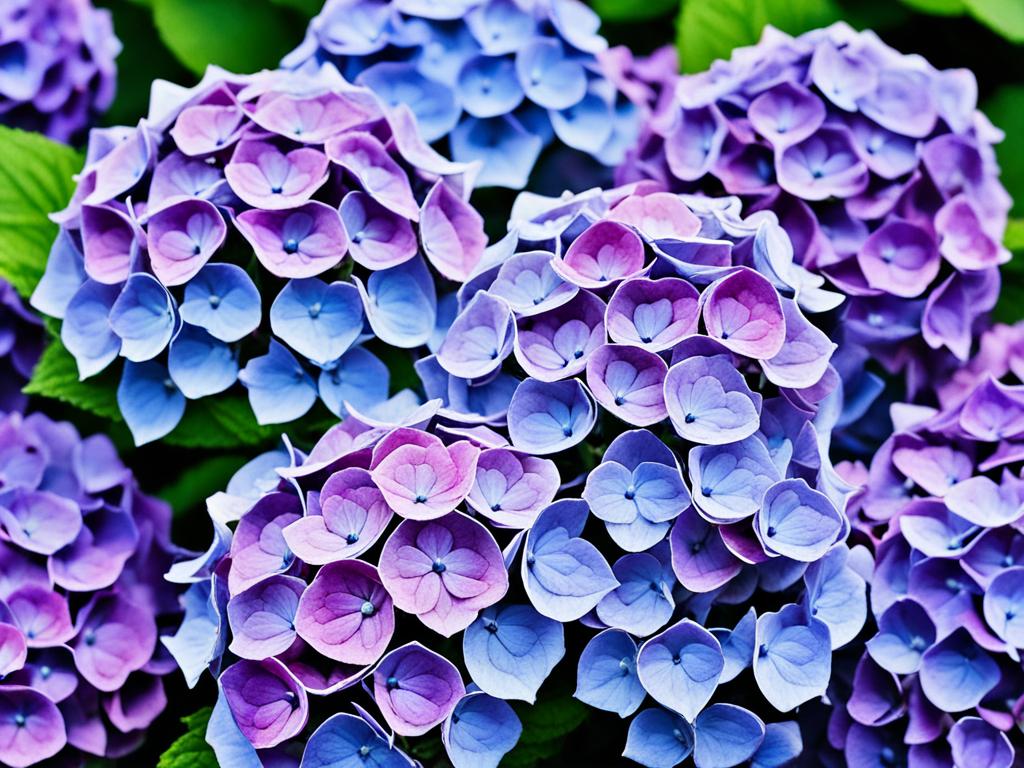I love gardening and the beauty of hydrangea flowers always catches my eye. These flowers can make any garden look stunning. But, have you ever thought about how long they last on the plant? Let’s dive into how long hydrangea blooms last and how to keep them looking great.
The hydrangea bloom duration changes with the type of hydrangea, the climate, and how well it’s cared for. In perfect conditions, hydrangeas bloom from mid-spring to late summer, or until the first frost. But, different hydrangeas bloom at different times and for varying lengths, each with its own care needs.
To get a clear picture of the hydrangea flower lifespan, we need to look at the different types of hydrangeas and their bloom times. By learning about hydrangea care, we can make sure our blooms last longer and stay beautiful all season.
Introduction to Hydrangea Blooms
Hydrangea plants are famous for their beautiful flower clusters. They catch the eye of gardeners and nature lovers. These shrubs have a special charm, with big, bright hydrangea flowers that can last weeks or even months. We’ll look into what makes hydrangea blooms last longer, giving you tips to enjoy their beauty for a longer time.
The Elegance and Allure of Hydrangea Flowers
Hydrangea blooms are known for their hydrangea bloom elegance and beauty. Their large, colorful clusters can go from soft pastels to bright colors. These flowers add beauty and charm to any garden, making them popular for landscaping and cut flower arrangements.
Exploring the Longevity of Hydrangea Blooms
The length of time hydrangea blooms last can change based on the type of hydrangea, growing conditions, and how well they are cared for. Some hydrangeas, like the Endless Summer series, can bloom several times in a season. By knowing what affects how long blooms last, gardeners can enjoy these beautiful flowers for longer.

Hydrangea Types and Their Bloom Seasons
Popular hydrangea varieties bloom at different times, from May to July or June to September. Knowing when each type blooms helps gardeners plan for a long-lasting flower show. This way, you can enjoy flowers all season long.
May to July Bloomers: Climbing and Oakleaf Hydrangeas
Climbing hydrangeas and oakleaf hydrangeas bloom from May to July. They are known for their beautiful, long-lasting flowers. These varieties are perfect for gardens in USDA Hardiness Zones 5-9.
June to September Bloomers: Bigleaf, Mountain, and Smooth Hydrangeas
Bigleaf, mountain, and smooth hydrangeas bloom from June to September. They offer a longer bloom time, often into the fall. These varieties are great for gardens in USDA Hardiness Zones 6-9.
| Hydrangea Variety | Bloom Season |
|---|---|
| Climbing Hydrangea | May to July |
| Oakleaf Hydrangea | May to July |
| Bigleaf Hydrangea | June to September |
| Mountain Hydrangea | June to September |
| Smooth Hydrangea | June to September |
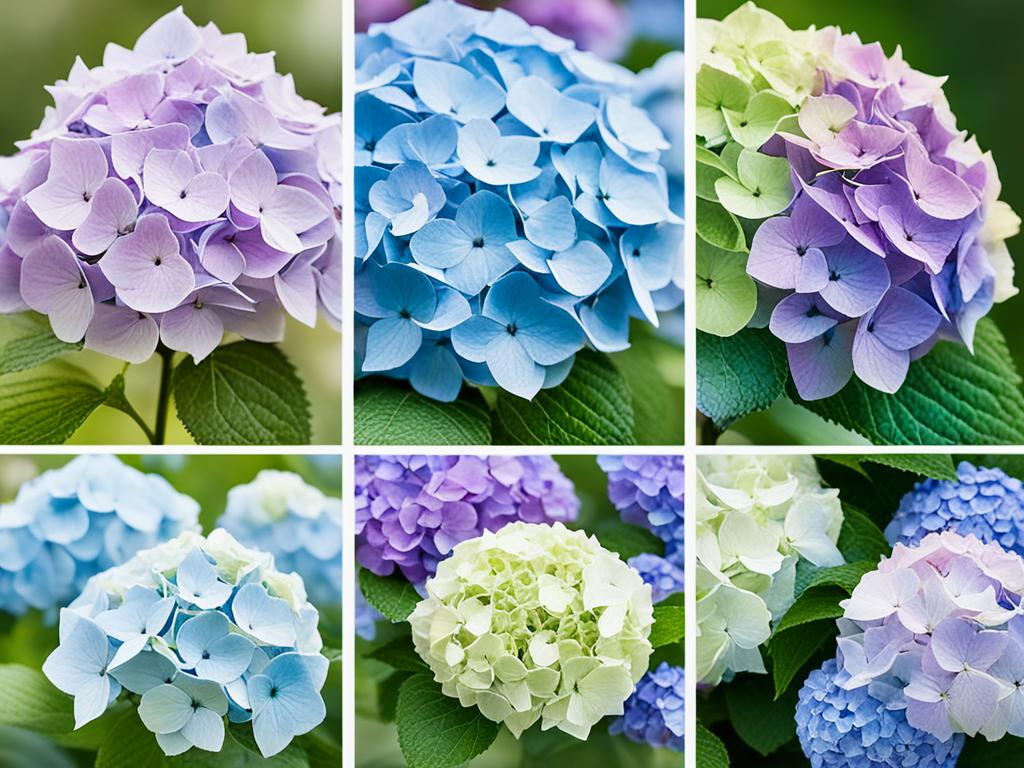
Choosing a mix of early, mid, and late-blooming hydrangeas creates a beautiful garden. This way, you’ll have flowers to enjoy all season long.
Temperature’s Impact on Hydrangea Bloom Duration
As a passionate gardener, I’ve found that temperature is key to hydrangea blooms lasting longer. These lovely flowers do best in moderate climates. Extreme temperature changes can affect how long they bloom.
Most hydrangeas like temperatures between 60°F to 80°F for blooming well. If they face harsh winter frosts or hot summer heat, their blooming time gets shorter.
- Climbing hydrangeas (Hydrangea petiolaris) typically bloom from May to July.
- Mountain hydrangeas (Hydrangea serrata) bloom from June to August.
- Bigleaf hydrangeas (Hydrangea macrophylla) and smooth hydrangeas (Hydrangea arborescens) bloom from June to September.
- Lacecap hydrangeas (Hydrangea macrophylla normalis) bloom from July to August.
- Panicle hydrangeas (Hydrangea paniculata) bloom from July to September.
Some hydrangeas, like mophead and lacecap types, can handle cooler temperatures. But even they can be hurt by too much frost or heat. This can make their blooms last less time.
Managing temperature well is key to making hydrangeas bloom for a long time. Knowing the best climate for your hydrangeas lets you create a perfect environment. This way, these beautiful flowers can bloom fully and brighten your garden for longer.
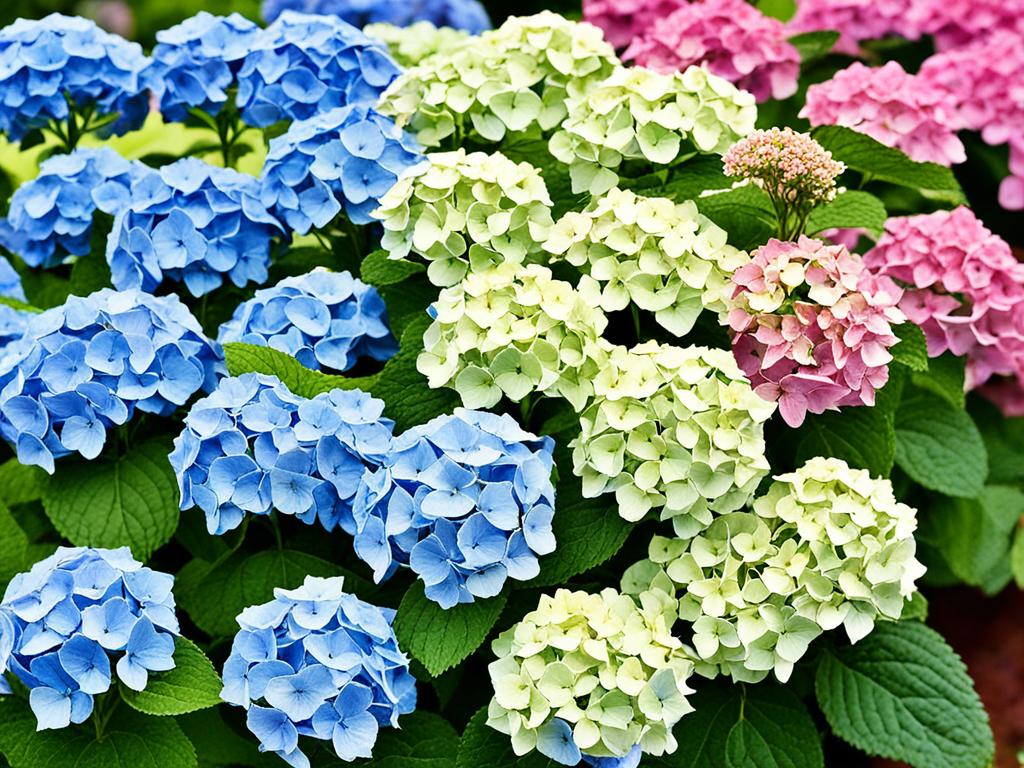
Planting Time and Hydrangea Bloom Longevity
When you plant hydrangeas, the timing can affect how long their blooms last. Planting them from fall to early spring lets the shrub build a strong root system. This is key for supporting bright flowers.
This best planting time helps hydrangeas adjust to their new spot before the growing season starts. This makes them ready for a long, blooming period.
Fall to Early Spring: The Ideal Planting Window
Hydrangeas do well when planted in the fall or early spring. This lets the plant work on building a strong root system. A solid root system supports the growth and length of the blooms.
Starting with a strong root system helps hydrangeas handle summer heat and drought better. This leads to healthier flowers that last longer.
Avoiding Heat Stress During Planting
The best time to plant hydrangeas is in the fall or early spring. But, it’s important to avoid heat stress during planting. Planting in the hottest parts of the day can cause wilting and delay flowers until next year.
To avoid this, plant hydrangeas in the early morning or late afternoon. These times are cooler, giving the plants a better chance to establish themselves without heat stress.
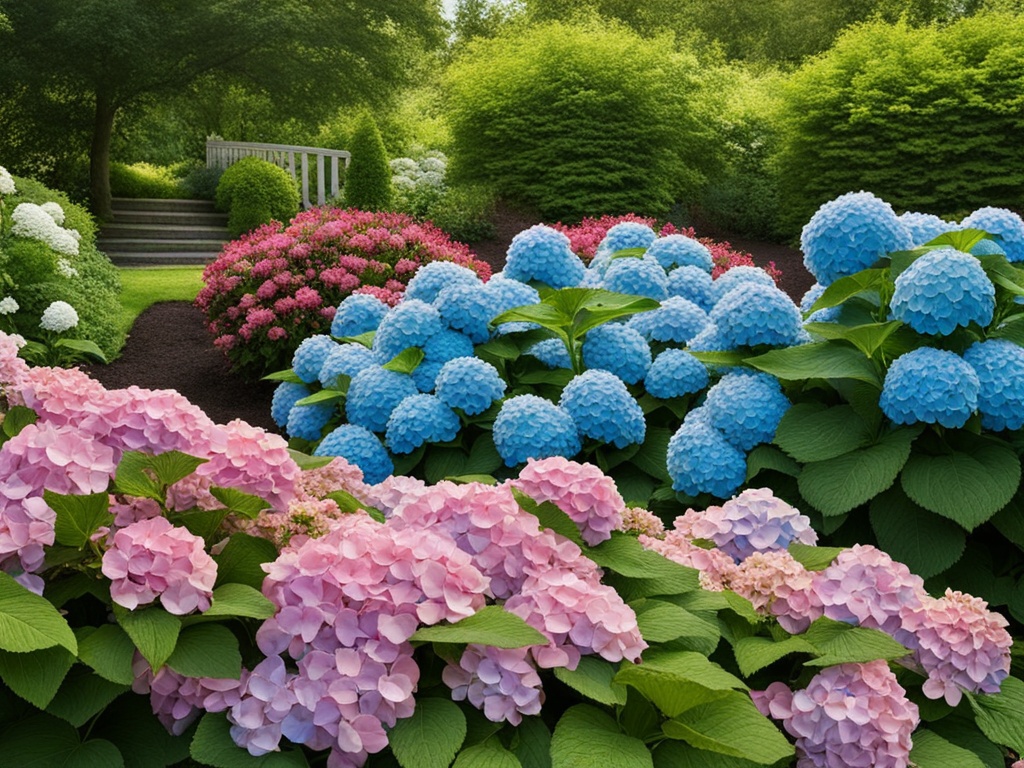
Choosing the right planting time and avoiding heat stress helps hydrangeas bloom beautifully for a long time. With some planning and care, these lovely flowers can brighten your garden for weeks.
Pruning Techniques for Prolonged Hydrangea Blooms
Proper pruning can make hydrangea blooms last longer. It’s important to know how to prune different types of hydrangeas. This keeps your garden looking vibrant and full of flowers.
Old Wood Hydrangeas: Timing is Key
Hydrangeas like mophead, lacecap, and bigleaf bloom on last year’s growth. Prune them right after they finish blooming, usually in summer. This avoids cutting off buds for next year’s flowers.
New Wood Hydrangeas: Deadheading for More Blooms
On the other hand, panicle and smooth hydrangeas bloom on this year’s growth. Deadheading their spent blooms encourages more flowers. Prune them in late winter or early spring, before new growth starts.
Reblooming Hydrangeas: The Best of Both Worlds
Reblooming hydrangeas bloom on both old and new wood. To keep them flowering longer, deadhead spent blooms. Also, trim the plant lightly in late winter or early spring for a healthy look.
| Hydrangea Type | Pruning Timing | Pruning Technique |
|---|---|---|
| Old Wood Hydrangeas (Bigleaf, Oakleaf, Mountain, Climbing) | After flowering, typically in summer | Prune to remove dead or weak stems, shape the plant |
| New Wood Hydrangeas (Panicle, Smooth) | Late winter or early spring, before new growth appears | Prune to stimulate vigorous new growth and more blooms |
| Reblooming Hydrangeas | Deadhead spent blooms, light trimming in late winter or early spring | Maintain shape and promote extended flowering period |
Knowing how to prune different hydrangeas helps gardeners get lots of blooms all season.
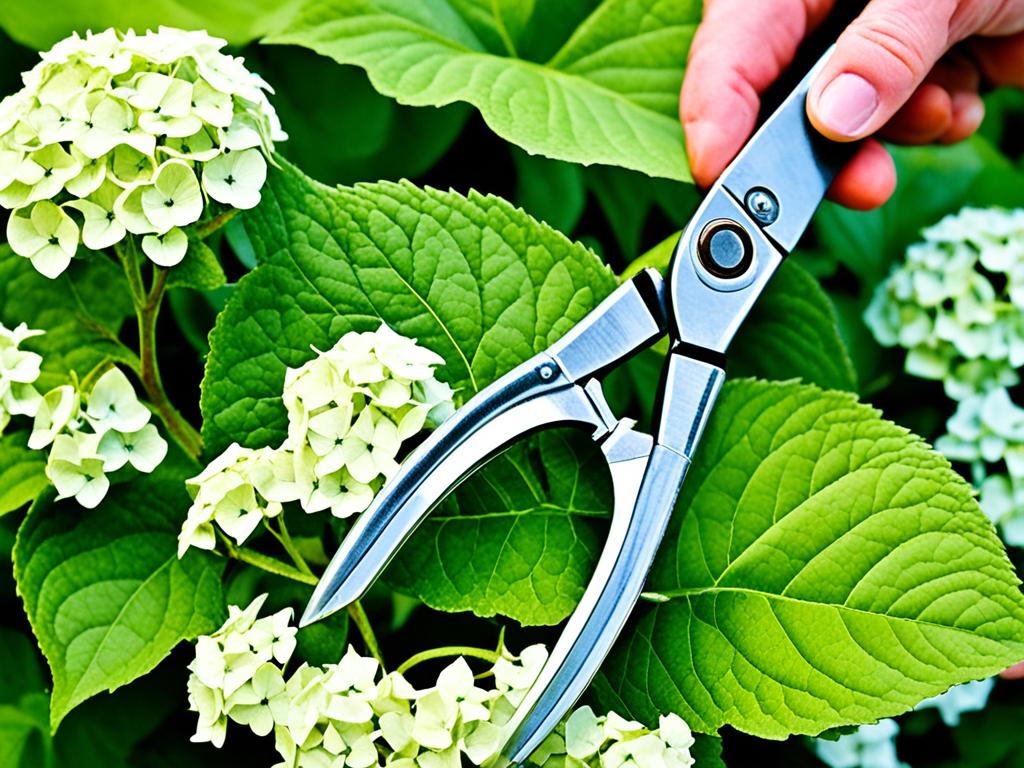
Soil Requirements for Optimal Hydrangea Blooms
Hydrangeas need the right soil to grow well and bloom beautifully. They do best in soil that’s rich in nutrients, drains well, and stays moist. This kind of soil helps them grow their stunning flowers.
To give your hydrangeas the best chance, use a special soil mix made just for them. This mix should be Earth-Positive, drain well, and full of nutrients. It meets hydrangeas’ needs and keeps their flowers going all season.
For hydrangeas to bloom well, the soil must be fertile. Use a slow-release fertilizer with lots of phosphorus in early spring or summer. But don’t overdo it, as too much fertilizer can make them focus on leaves instead of flowers.
Hydrangeas like certain soil pH levels. The color of their flowers can change based on the soil’s acidity or alkalinity. For blue flowers, keep the soil pH below 6.0. For pink flowers, keep it above 6.0. You can change the soil pH with things like aluminum sulfate, composted oak leaves, or wood ashes.
Give your hydrangeas the right soil, and they’ll get the nutrients, drainage, and pH they need. This way, they’ll thrive and show off their beautiful flowers for a long time in your garden.
| Soil Requirement | Ideal Condition |
|---|---|
| Soil Type | Nutrient-rich, well-draining loam with at least 5% organic matter |
| Soil pH | Below 6.0 for blue blooms, above 6.0 for pink blooms |
| Soil Amendments | Aluminum sulfate, composted oak leaves, or wood ashes for blue blooms; lime or phosphorus-rich fertilizers for pink blooms |
| Fertilizer | Slow-release, granular fertilizer high in phosphorus applied in early spring or early summer |
| Soil Moisture | Consistently moist, well-draining soil |
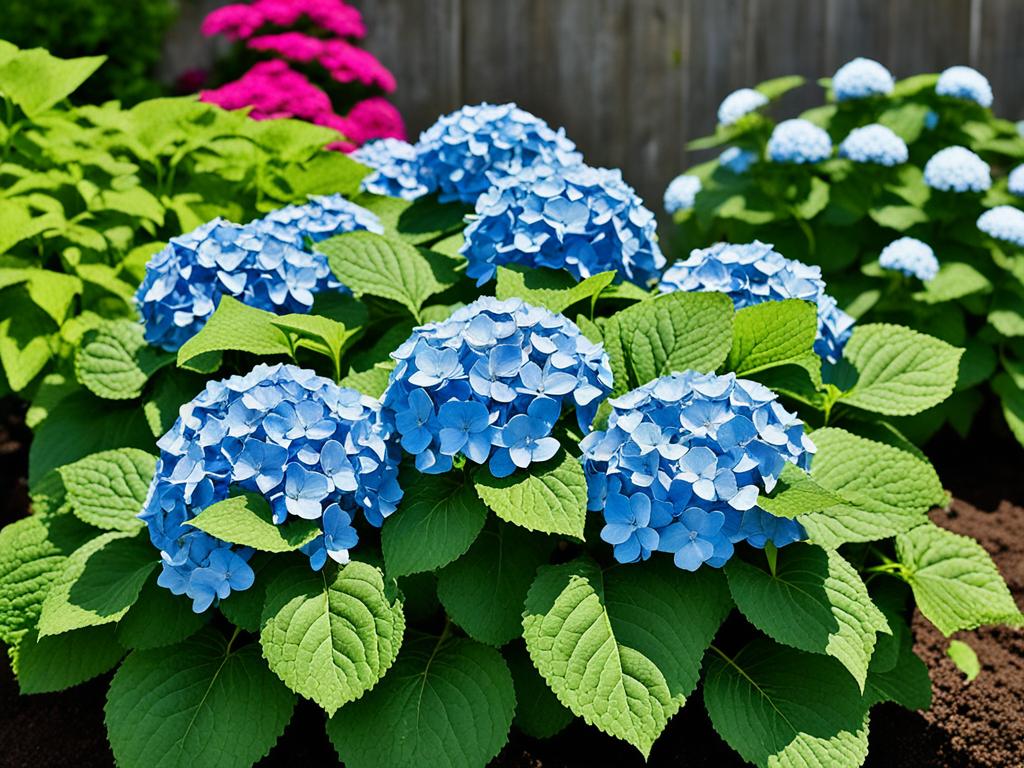
By knowing what hydrangea soil requirements, hydrangea soil fertility, and hydrangea soil nutrients are needed, you can make the perfect soil for these lovely plants. This way, you can enjoy their beautiful and lasting blooms.
Light Exposure and Hydrangea Bloom Longevity
Hydrangeas need the right amount of light to keep their blooms going. Most types do well in partial shade. They like early morning sun but need protection from the strong afternoon sun.
By placing hydrangeas in shaded spots with indirect sunlight, you can make their flowers last longer. This also keeps them safe from strong winds and direct sunlight.
Bigleaf hydrangeas bloom on old wood and should be pruned in summer after they finish flowering. Panicle hydrangeas bloom on new wood and get pruned in winter or early spring. Oakleaf hydrangeas, with their beautiful fall colors, flower on old wood and need little pruning, done in summer after blooming.
Smooth hydrangeas love bright, indirect light and are cut back to the ground in late winter or early spring. This encourages more flowers. Knowing the light and pruning needs of each type helps make their blooms last longer.
| Hydrangea Type | Bloom Season | Pruning Timing | Light Preference |
|---|---|---|---|
| Bigleaf Hydrangea | June to September | Summer after blooming | Partial shade |
| Panicle Hydrangea | June to September | Winter or early spring | Partial shade |
| Oakleaf Hydrangea | May to July | Summer after blooming | Partial shade |
| Smooth Hydrangea | June to September | Late winter or early spring | Bright, indirect light |
Knowing the light and pruning needs of hydrangeas helps you enjoy their beauty for longer. This way, you can have a stunning garden display.
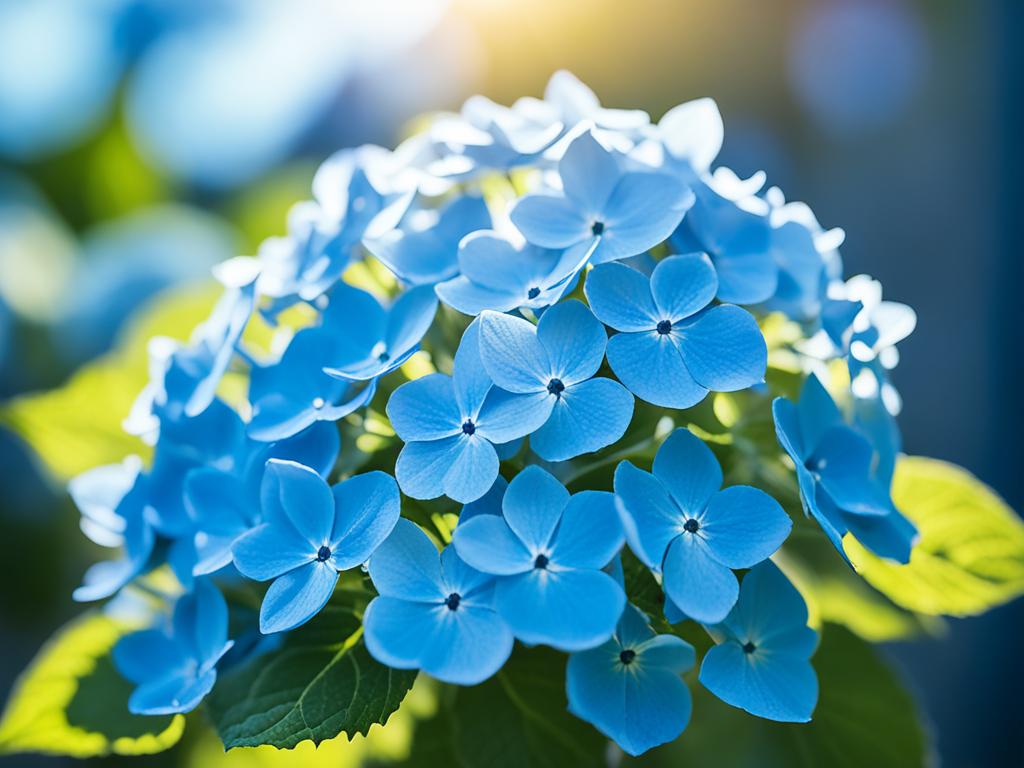
Watering Practices for Vibrant Hydrangea Displays
Proper watering is key for keeping your hydrangeas looking great. These flowers need consistent moisture. Make sure the soil is moist but not too wet. Water them when the top 2-3 inches of soil feel dry, best in the early morning or evening to cut down on evaporation.
Hydrangeas grow fast, about 2 feet a year, and can get quite tall, up to 15 feet. They do well in zones 3 to 9. New hydrangeas need water every 1 to 2 days to grow strong roots.
Once they’re established, water them deeply 1-2 times a week. You might need to water more often when it’s hot and dry to stop them from wilting. Keeping the soil consistently moist is important. Mulching around the plants helps keep moisture in and keeps the soil cool.
- Hydrangeas in containers may require more frequent watering compared to those planted in the ground.
- Adjusting the soil pH can influence the color of your hydrangea blooms, with acidic soil producing blue flowers and alkaline soil resulting in pink flowers.
By following these watering tips, your hydrangeas will get the right amount of water to stay healthy and show off their beautiful blooms all season.
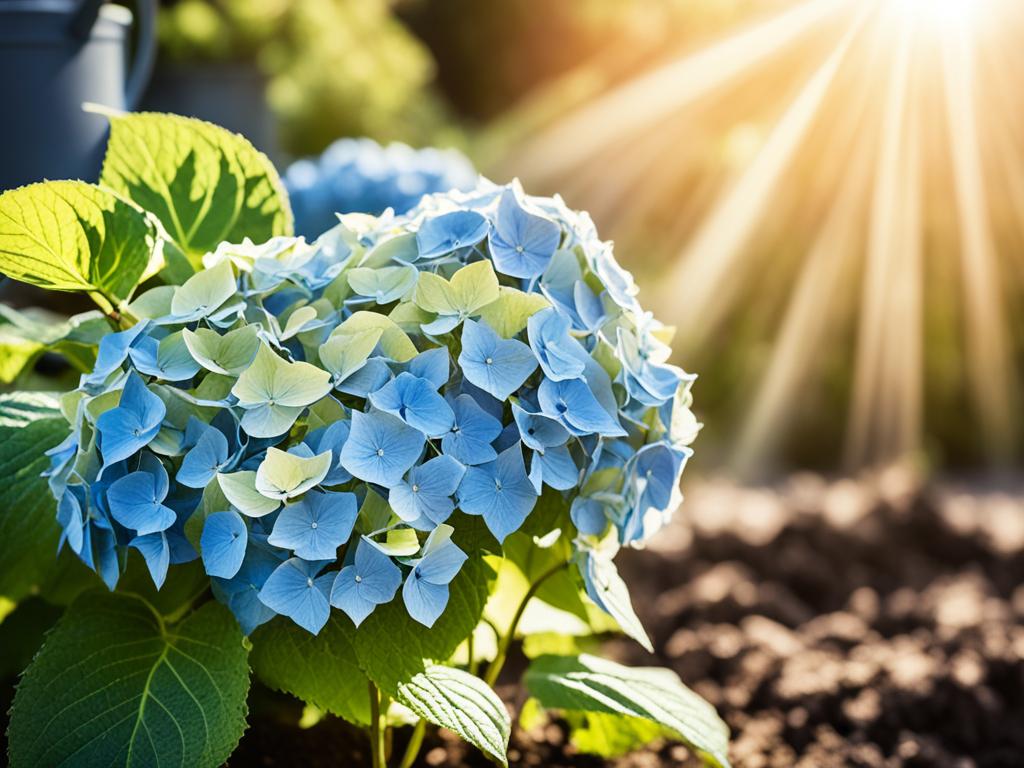
How long do hydrangea blooms last on the plant?
Factors Influencing Bloom Duration
Hydrangea blooms can last up to 2 months under the best conditions. But, many factors can change how long they bloom. These include the type of hydrangea, the weather, when you plant it, how you prune it, the soil quality, how much light it gets, and how often you water it.
Tips for Maximizing Blooming Time
To make hydrangeas bloom longer, you need to create the right conditions. Here are some tips to help:
- Pick hydrangeas that bloom at different times. For example, Hydrangea petiolaris and Hydrangea quercifolia bloom from May to July. Hydrangea macrophylla and Hydrangea arborescens bloom from June to September.
- Plant hydrangeas in the fall or early spring. This lets them grow strong before they start blooming.
- Prune hydrangeas at the best time. Cut back old wood bloomers in late winter. New wood bloomers should be pruned in late spring. Rebloomers should be pruned in late winter or early spring.
- Make sure your hydrangeas have the right soil. It should be rich in nutrients, drain well, and keep moisture.
- Give your hydrangeas the right amount of light. Most prefer partial shade. But Hydrangea paniculata can handle full sun.
- Water your hydrangeas often. Keep the soil moist but not too wet.
- Feed your hydrangeas with organic fertilizers. This helps them grow and bloom better.
- Keep your hydrangeas safe from pests and diseases using natural methods.
By following these tips, you can make your hydrangeas bloom longer. Enjoy their beautiful flowers all season.
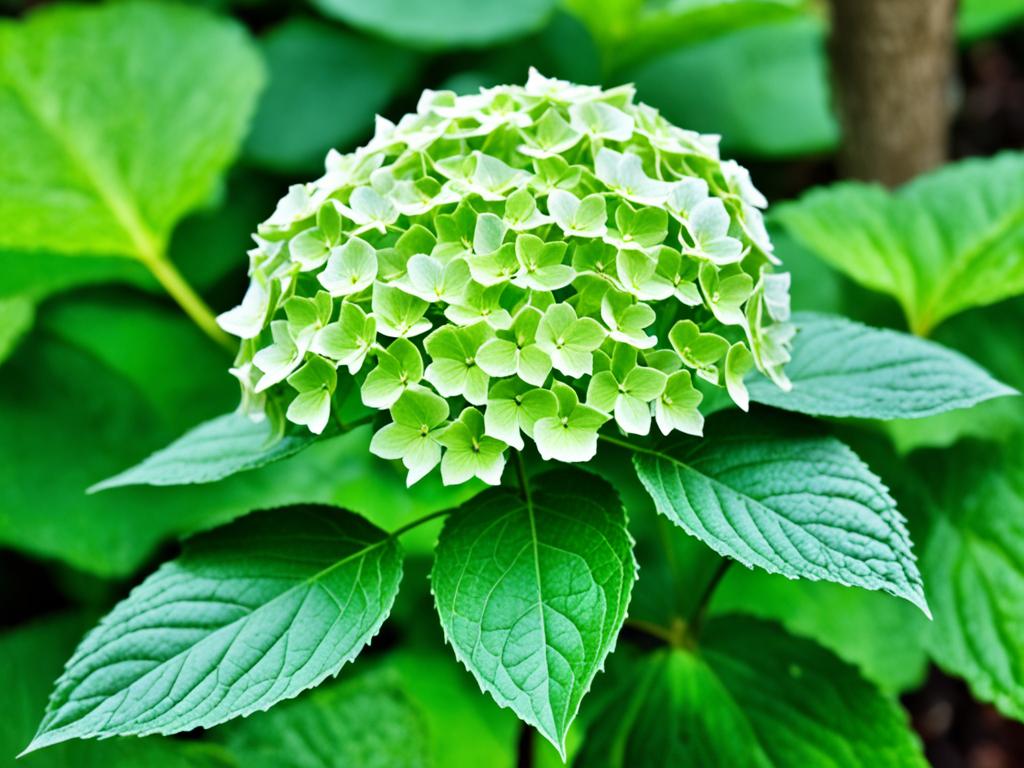
Nutrient Needs for Healthy Hydrangea Blooms
For a healthy hydrangea plant, finding the right nutrient balance is key. These plants need a lot of nutrients to produce beautiful blooms. Giving them the right food can make a big difference.
To get big, beautiful flowers, feed your hydrangeas in the spring with a special fertilizer. Use a 15-10-10 or 10-5-5 formula, which is great for roses too. This kind of fertilizer helps make more flowers. But, don’t give them too much nitrogen, as it can stop flowers from growing and make too much leaf.
It’s important to keep an eye on the hydrangea nutrient requirements all season. A balanced 10-10-10 fertilizer is good for growth. But, for bigger flowers, a fertilizer made for roses might work better.
When to fertilize your hydrangeas is also important. If they’re in the ground, feed them in early spring, early May, and late June/early July. If they’re in pots, you can fertilize twice, once in early spring and again in May.
By giving your hydrangeas the right nutrients at the right times, you’ll get beautiful, long-lasting flowers. Your garden will be the talk of the town.
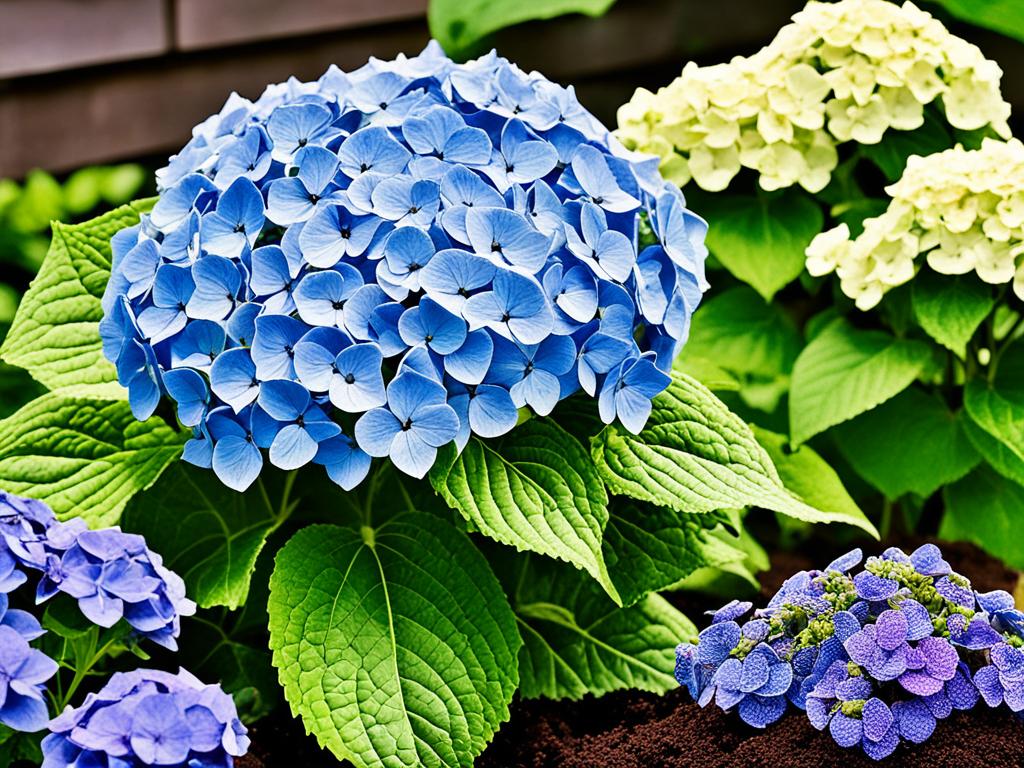
“Fertilizing hydrangeas is essential for promoting healthy growth and impressive blooms. The key is striking the right balance of nutrients to support both the plant’s foliage and its floral display.”
Pest and Disease Prevention for Lasting Blooms
Keeping your hydrangea blooms looking great means watching out for pests and diseases. Using the right pest control and prevention methods is key to keeping your flowers bright and long-lasting.
Aphids are a big problem for hydrangeas. These tiny insects suck the sap, making flowers look bad and grow poorly. Using organic insecticides like Sevin Insect Killer can get rid of aphids and protect your hydrangeas.
Fungal diseases like powdery mildew and leaf spot can hurt your hydrangeas too. Applying a fungicidal spray like Daconil can stop these diseases and keep your plants healthy. Make sure your hydrangeas have good air flow and don’t stay wet to prevent these diseases.
- Employ Sevin Insect Killer to control aphids and other pests.
- Use Daconil Fungicide to prevent powdery mildew, leaf spot, and botrytis blight.
- Ensure adequate air flow and avoid moisture on leaves to deter fungal diseases.
Stay alert and deal with any hydrangea pest control or hydrangea disease prevention problems fast. This way, you can enjoy your hydrangea blooms for a longer time.
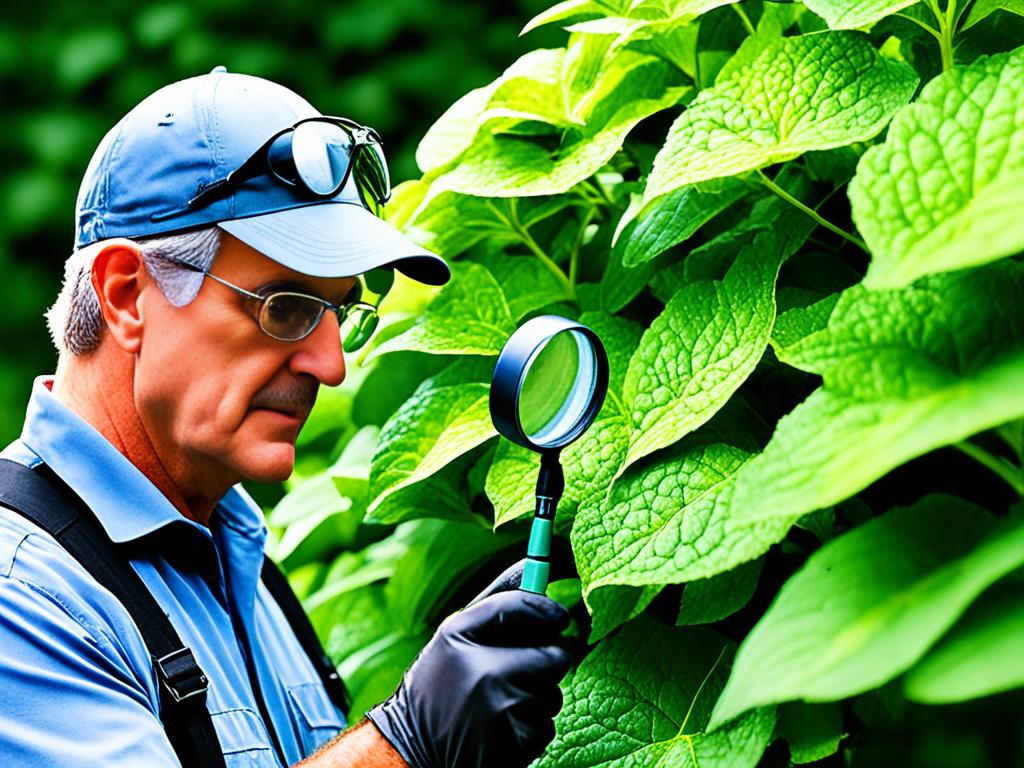
“Protecting your hydrangea blooms from pests and diseases is crucial for maintaining their vibrant beauty throughout the season.”
Extending the Season with Dried Hydrangea Blooms
Even after they stop blooming, dried hydrangea blooms can still add beauty to your space. As they dry, they turn into a beautiful, aged look that can make any decor pop.
By drying hydrangea flower clusters, you can make them last longer. This simple method lets you enjoy these lovely flowers for more of the year. You can use them in DIY projects or professional designs to keep their beauty alive.
For gardeners and flower lovers, learning to dry hydrangea flowers opens up many creative possibilities. Dried hydrangeas can be used in everything from rustic wreaths to fancy centerpieces. They are incredibly versatile.
“Dried hydrangea blooms add a timeless elegance to any space, and the process of preserving them is both rewarding and easy to accomplish.”
When your hydrangeas stop blooming, don’t let their beauty disappear. Use the chance to extend the season with dried hydrangea flowers. They will add a magical touch to your home.
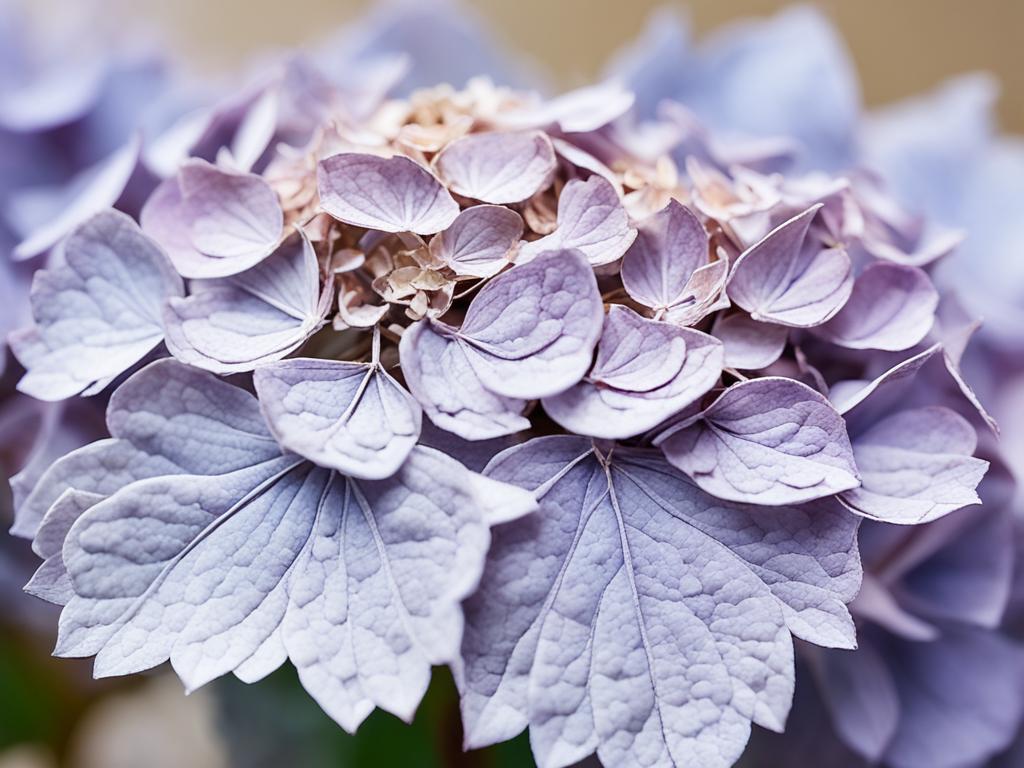
| Hydrangea Variety | Bloom Season | Dried Bloom Lifespan |
|---|---|---|
| Hydrangea Petiolaris (Climbing Hydrangea) | May to July | 2-3 months |
| Hydrangea Macrophylla (Bigleaf and Mophead Hydrangea) | June to September | 3-4 months |
| Hydrangea Paniculata (Panicle Hydrangea) | July to September | 4-5 months |
Knowing when different hydrangea varieties bloom and how long their dried blooms last helps you plan. This way, you can enjoy these beautiful flowers for as long as possible.
Conclusion
The life of hydrangea blooms depends on many things, like the type you pick and how you care for them. By knowing how to make hydrangeas bloom longer and better, gardeners can enjoy these beautiful plants more. They can make their gardens look great for a long time.
Choosing the right hydrangeas for your area and planting them at the best time is key. Also, making sure they have good soil, enough light, and water is important. Proper pruning can also make them bloom longer. And, drying hydrangeas can keep your garden looking good even when they’re not in season.
With the right hydrangea care tips and focus on maximizing hydrangea blooms, you can have beautiful and long-lasting hydrangeas. By using this advice, your garden will be a beautiful place all year round.
FAQ
How long do hydrangea blooms typically last on the plant?
Under ideal conditions, hydrangea flowers can last about 2 months on the plant.
What factors influence the longevity of hydrangea blooms?
Many things affect how long hydrangea blooms last. These include the type of hydrangea, temperature, when you plant it, pruning, soil quality, light, and how often you water it.
How can I extend the blooming period of my hydrangeas?
To make your hydrangeas bloom longer, pick the right types, plant them at the best time, and give them the right soil, light, and water. Also, use proper pruning.
What are the different hydrangea bloom seasons?
Hydrangeas bloom at different times. Some, like climbing and oakleaf hydrangeas, bloom from May to July. Others, like bigleaf, mountain, and smooth hydrangeas, bloom from June to September.
How does temperature affect the duration of hydrangea blooms?
Temperature is key to how long hydrangea blooms last. Most hydrangeas like moderate temperatures. Extreme cold or heat can shorten their blooming time.
When is the best time to plant hydrangeas for longer-lasting blooms?
Plant hydrangeas in fall or early spring. This lets the plant grow a strong root system for better blooms. Make sure to avoid heat stress when planting.
How do pruning techniques impact the longevity of hydrangea blooms?
Cutting back hydrangeas correctly is important for long-lasting blooms. Different types need different pruning. This helps them bloom more and longer.
What soil conditions are ideal for hydrangea bloom longevity?
Hydrangeas do well in rich, well-draining, moist soil. Using a special hydrangea soil mix can give them the nutrients they need for great blooms.
How does light exposure affect the duration of hydrangea blooms?
Most hydrangeas like some shade, especially in the afternoon. Putting them in a spot with indirect sunlight can make their flowers last longer.
What are the best watering practices for maintaining vibrant hydrangea blooms?
Hydrangeas need steady moisture but not too much. Water them when the top 2-3 inches of soil are dry, in the early morning or evening. This keeps their blooms vibrant.
